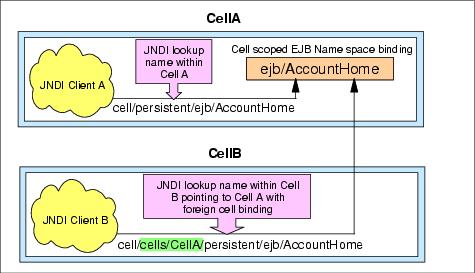
11.8 Foreign cell bindings
A foreign cell binding is a context binding that resolves to the cell root context of another cell. You can configure a foreign cell binding such that applications in your cell can access applications and other resources within the other cell. Foreign cell bindings consist of one or more bootstrap addresses for a given cell. The bootstrap address consists of the name of the bootstrap host and a port number that it listens on. This concept places the bootstrap addresses in a single location, instead of every reference to the foreign cell in the application deployment data. If the bootstrap information changes, this can be updated in a central location, just once via the administration console. No applications need to be updated, as all objects in the foreign cell are looked up through the central bindings.
Figure 11-4 depicts an example, where we have a cell "CellA" that has a cell-scoped EJB name space binding configured with a name in the name space /ejb/AccountHome. Applications running in CellA would look up the home with a JNDI name of cell/persistent/ejb/AccountHome (actually J2EE applications would use a java:comp/env name that maps to that JNDI name through the application deployment descriptors). With a foreign cell binding configured in CellB that points to CellA, applications in CellB can do the same lookup with a JNDI name of cell/cells/CellA/persistent/ejb/AccountHome.
Figure 11-4 JNDI lookup names using a foreign cell binding |

